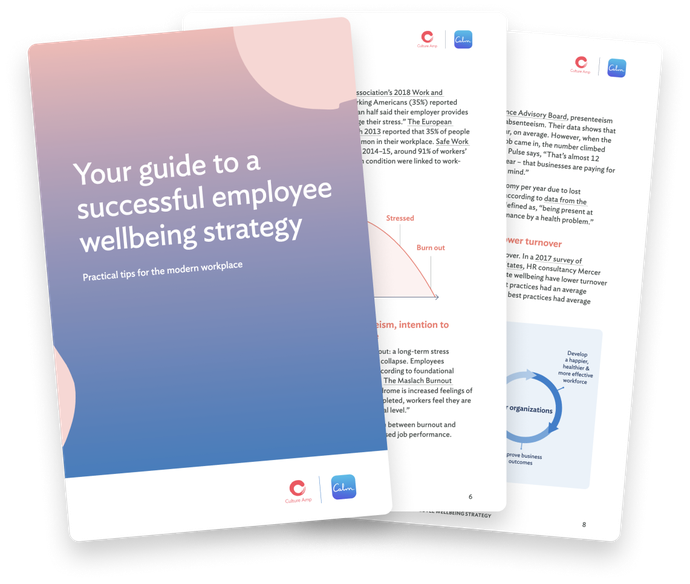How to recognize and reverse employee burnout

Burnout is frequently portrayed as a sudden life event, often accompanied by an image of someone who is completely frazzled, with dark circles under their eyes, and barely able to function. But as we know, this isn't quite the case. Stress and negative wellbeing are gateways to burnout. It’s something that’s built up over time. Burnout is a long-term stress reaction that can present as physical and/or mental collapse.
Another common myth is that burnout only impacts people in very senior roles or those with emotionally stressful jobs such as nurses or medical doctors. However, it’s a serious issue and something affecting many employees today across a range of industries and roles. This is especially the case as we, as a society, continue to work through uncertainty.
According to The American Psychological Association’s 2022 Work and Well-Being Survey, “Seven in 10 workers (71%) believe their employer is more concerned about employees' mental health now than in the past. This new focus is highly valued by employees. In fact, 81% of individuals said they will look for workplaces supporting mental health when seeking future job opportunities." Yet, despite this new focus, over a quarter of employees reported feeling burnout symptoms in 2022, according to a study by McKinsey.
In this article, we explore some of the warning signs of employee burnout, how it relates to employee engagement, and how workplaces can prevent and even reverse burnout.
Recognizing the signs of employee burnout
Burnout can affect an employee’s physical, mental, and emotional state.
Physical consequences
Are you noticing employees taking more sick days or coming into the office seeming exceptionally tired? These can be signs of burnout. An employee who is burning out may be experiencing:
- Headaches
- Fatigue
- Shortness of breath
- Loss of appetite and change in eating habits
- Increased illness and absenteeism
- Shortness of breath
- Insomnia
Mental consequences
Mentally, burnout brings on constant worry and the inability to focus clearly. Symptoms can include:
- Distraction and poor attention span
- Inability to work productively
- Lack of work-life balance
- Poor decision-making
- Lack of motivation
Emotional consequences
Emotionally, people are more irritable which can lead to poor interpersonal communication. For example, a burnt out employee may start showing more of the following traits:
- Cynicism
- Detachment
- Irritability
- Increase in conflict and harsh comments
- Higher emotional fragility (i.e., getting upset or tearing up more than usual)
Overall, pay attention to people who just don’t seem like themselves and if their attitudes have changed.
Listen out for early indicators in phrases such as:
- “I just haven’t been feeling like myself lately.”
- “I just need to get through this busy season, and then I’ll slow down.”
- “I’m just tired – I’m sure a vacation will take care of it.”
In all of these scenarios, having an open and honest relationship with the people on your team will help you recognize when their behavior changes from stress to burnout.
The link between employee burnout and employee engagement
The connection between engagement and burnout is not straightforward because highly-stressed individuals can present as very engaged. This is certainly evident through my own experience. I was working in London, and my workload, hours, and commitments just kept creeping up. While I hadn't recognized it then, my work-life integration was entirely off.
I remember feeling annoyed at my friends when they asked me to meet them for dinner on a weeknight. I became much more serious (which is a stark contrast to my usual self). But I didn't realize anything was wrong until my hair started falling out, which was a wake-up call. So I worked with a health coach to get back on track, and that’s when I started getting more interested in recognizing and reversing burnout.
During this time, I would still have said I was engaged at work. High engagement and high levels of wellbeing do not always go together. Individuals can feel highly stressed while being engaged, but they may be on their way to burnout. This is an important distinction for employers to understand, and it’s part of why we created the wellbeing survey at Culture Amp.
By conducting an employee survey that asks questions about wellbeing, you can measure the state of wellbeing in your company, and take the necessary action to help your people be healthier, happier, and more productive.

Learn more about employee wellbeing at work
Get the guideHow to reverse employee burnout
Part of preventing employee burnout is, of course, knowing the signs so you can take action before it gets worse. In addition to the three signs mentioned above, understand people’s stress levels in your 1-on-1 meetings. You can learn a lot about someone’s wellbeing with these simple opening questions: How is everything going today? Tell me about this last week?
If you know people on your team are burnt out, it’s time to act. Often people experiencing burnout lose their perspective on work, and it becomes all-consuming. One of the most effective things managers can do is support employees to take the time they need to recover from burnout. Letting people unplug from work and focus on their health is the first step.
You can also consider:
- Rebalancing workloads - Check in with the employee to see if they feel adequately supported. If not, see what resources or help they may need to better manage their workload.
- Helping the employee set healthy boundaries - Does the employee feel compelled to answer work messages, even after they've logged off? Do they feel like they're not allowed to take a break or say "no" when somebody asks for help? Have an honest conversation with them to see how you can support them.
Fast-paced, high-growth situations often demand as much as people are willing to give, so it’s up to employees (and their managers) to establish boundaries and realistic expectations. Something I tell people is to assume that they are always at risk of burnout. This isn’t meant to be ominous or scary. I just wanted to highlight the importance of investing in ongoing self-care. Have a bank of strategies that help you feel better, and tap into them when you’re stressed. Know what refuels you and build it into your daily routine.
Here are some daily practices you can incorporate in your life to prevent burnout:
- Prioritize good sleep. Set a pre-bedtime ritual to help your body relax and get the most of your restoration
- Spend time in nature. (there is plenty of science supporting the restorative properties of green space)
- Take a mental break. During the day, relax (not checking email, slack, or anything work-related). Call a friend, go outside, and close your eyes for five minutes – whatever you choose, let yourself disconnect for that time.
- Log off. Do what's necessary to unplug after work. For example, you can set your Slack notifications to only come through during work hours. If unplugging is particularly hard for you, you can ask your roommate, friend, partner, family member, etc. to "lock up" your work laptop and phone.
- Set time for self-reflection. Use this time to reflect on your needs, emotional state, and goals. Assess whether or not what you're doing works for you or if you need to take action to prioritize your own self-care and wellbeing better.
I also recommend finding restoration practices that work for you and using them to take stock of how you’re feeling over time. For instance, I have a weekly yoga practice, and if I miss a week, I know something is up. This helps me monitor my wellbeing so I don’t get overly stressed. To help maintain perspective, build a well-rounded life but not a manic one. What else do you get joy from? What can you learn? What will give you a sense of progress? It might be new hobbies, volunteering, or even learning how to do handstands – experiment and build new things into your life.
Our work can give us an incredible sense of meaning and purpose, but it shouldn’t be the only thing.
This article was originally published on March 3, 2019. It was updated with new information on April 5, 2023.






